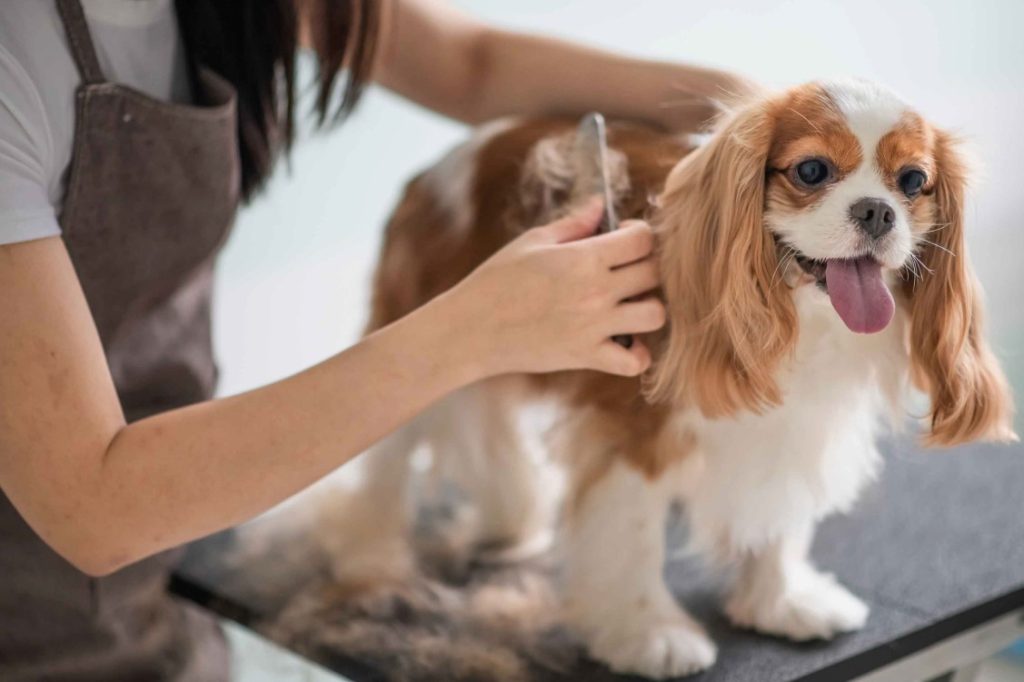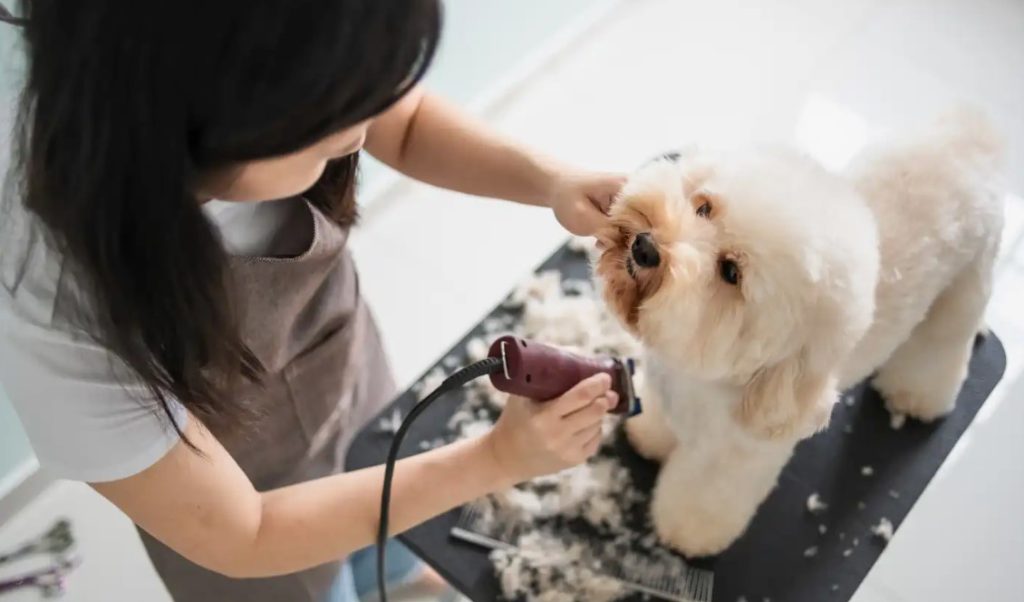
Essential Steps, Benefits, and the Convenience of Mobile Grooming Services
Maintaining a dog at home involves more than just nutritious meals and regular exercise. Effective care for a pet also requires hygienic grooming—a process that is not merely aesthetic but also foundational for the health and well-being of your furry friend. Hygienic grooming goes beyond regular brushing, encompassing a series of carefully performed steps that keep your pet’s coat, skin, eyes, ears, and teeth clean and in optimal health. For a convenient and stress-free experience, services like Pets in the City offer expert grooming tailored to meet the needs of dogs across various life stages.
Key Components of Hygienic Grooming for Dogs
1. Coat Combing and Brushing
Regular combing helps remove loose hairs, prevent tangles, and reduce shedding. Different brushes are used depending on the coat type; for example, slicker brushes work well on long-haired breeds, while bristle brushes are suited for shorter coats. Proper brushing prevents mats, which can be uncomfortable or painful if left untreated.
2. Customized Haircuts
Haircuts vary based on breed, coat type, and even the season. For instance, double-coated breeds might need their coats trimmed during hotter months, but careful consideration is required to avoid cutting the protective undercoat too short. Personalized haircuts also take the owner’s preferences into account, creating a style that’s both functional and visually appealing.
3. Eye Hygiene
Cleaning the area around the eyes is critical, especially for breeds with prominent eyes or long facial fur. Tear stains, which are common in light-colored dogs, are gently removed with suitable solutions, and the eye area is kept clean to prevent irritation or infections. Eye hygiene not only keeps your pet looking fresh but also supports ocular health.
4. Ear Cleaning and Maintenance
Ear care prevents the accumulation of wax, dirt, and moisture, which can lead to infections. Certain breeds, such as those with floppy ears or a high level of hair within the ear canal, are more prone to ear issues. Gentle cleaning with cotton pads and veterinarian-recommended antiseptic solutions keeps ears healthy and reduces the risk of complications.
5. Oral Care and Teeth Brushing
Dental hygiene is essential to prevent gum disease, which can lead to more serious health issues. Specialized dog toothbrushes, enzymatic toothpaste, and dental chews help reduce plaque buildup. Regular brushing keeps your dog’s breath fresh and maintains healthy gums, which are key to overall wellness.
6. Nail and Claw Trimming
Trimming nails is vital for comfort and mobility. Overgrown nails can affect a dog’s gait and cause discomfort, particularly on hard surfaces. Depending on the thickness of the nails, groomers use either claw cutters or grinders to trim claws safely, ensuring they don’t split or bleed.
7. Bathing and Shampooing
Regular baths keep the skin and coat free of dirt, allergens, and parasites. Dog-friendly shampoos are formulated to balance the skin’s pH level, preventing dryness and itchiness. Depending on coat type and needs, conditioners are also used to keep fur soft and manageable.
8. Drying and Finishing Touches
Once the bath is complete, the coat is towel-dried and then blow-dried. The drying process is important for keeping the coat neat and preventing matting, particularly in longer-haired breeds. Finally, a finishing brush smooths the coat, leaving it clean, soft, and shiny.

Frequency of Grooming Based on Age and Life Stage
To maintain the health and comfort of your dog, grooming frequency should be adjusted according to their age and developmental stage:
Puppies (up to 16 weeks)
Once every 7-10 days. Puppies have sensitive skin and require gentle grooming with soft brushes and mild, hypoallergenic shampoos. Early grooming helps acclimate young dogs to the process, making it easier as they grow.
Adolescent Dogs (up to 12 months)
Every 2 weeks. Adolescents go through coat changes, and regular grooming assists in managing these transitions. Monthly deep cleansing with hydrophilic shampoos is also recommended to keep the coat looking healthy.
Adult Dogs (up to 10 years)
Once a month. Adult dogs generally benefit from monthly grooming sessions that include texturizing shampoos suited to their coat type, ensuring the fur remains manageable and skin stays healthy.
Senior Dogs (over 10 years)
Every 1.5 to 2 months. Mature dogs need gentler treatments to support skin elasticity and coat health. Nourishing conditioners, gentle massages, and moisturizing serums keep senior dogs comfortable and reduce the likelihood of skin issues.
The Benefits of Regular Hygienic Grooming
1. Enhanced Physical Appearance
A well-groomed dog looks neat and feels more comfortable. Clean fur, clear eyes, and tidy ears give a polished appearance that reflects good health and care.
2. Prevention of Health Issues
Grooming minimizes risks of skin infections, ear infections, dental problems, and eye irritations. For example, regular ear cleaning helps avoid infections, especially in breeds prone to ear issues. Similarly, dental care prevents plaque buildup and gum disease, which can impact other organ systems over time.
3. Healthy Skin and Coat
Regular grooming keeps the coat shiny and soft. Conditioning closes keratin scales, enhancing the coat’s resilience and giving it a glossy finish. Grooming also promotes natural oil distribution, which moisturizes the skin and reduces itching and flakiness.
4. Early Detection of Parasites
Grooming allows pet owners and groomers to spot fleas, ticks, or other parasites early. This is particularly important for dogs who spend time outdoors or in areas where parasites are prevalent. Timely detection helps prevent the spread of parasites and keeps your dog more comfortable.
5. Bonding and Behavioral Benefits
Grooming time can be a bonding experience between you and your dog. Dogs who are regularly groomed become more comfortable with human touch and are often better behaved during these sessions. This routine reinforces trust and relaxation, which benefits both the pet and the owner.
The Rise of Mobile Grooming Services
In busy cities, mobile grooming services have become a practical solution for pet owners who want high-quality grooming without leaving home. These services bring the groomer’s expertise and equipment to your door, offering a personalized grooming experience that is both convenient and stress-free for your pet.
Pets in the City in Dubai is a notable example of a mobile grooming service that brings expert care directly to pet owners. Equipped with professional grooming tools, mobile groomers can perform all necessary grooming procedures from haircuts to nail trims in the comfort of the pet’s own environment.

Advantages of Mobile Grooming
Convenience
With mobile grooming, there’s no need to worry about transporting your pet. This is especially helpful for owners with hectic schedules or for pets who may experience anxiety in unfamiliar environments.
Comfort for the Pet
Dogs can feel stressed in unfamiliar grooming salons filled with other animals and unfamiliar scents. By grooming at home, pets stay in a more familiar environment, which often results in a calmer, more positive experience.
One-on-One Attention
Unlike traditional salons, mobile groomers usually work with one pet at a time, providing focused, individualized care. This tailored approach ensures that each grooming session is customized to meet your dog’s specific needs and preferences.
Time Efficiency
Mobile grooming is often more time-efficient than visiting a salon, as there’s no waiting time, making it ideal for busy pet owners.
Choosing the Right Mobile Groomer
When selecting a mobile groomer, consider their experience, certifications, and the quality of their equipment. Look for a groomer who uses pet-safe, eco-friendly products and understands breed-specific grooming requirements. Groomers who are certified by reputable organizations often have the skills and knowledge needed to handle pets gently and professionally.
Tips for Maintaining Your Dog’s Grooming Routine at Home
Between professional grooming sessions, maintaining some grooming practices at home helps keep your dog comfortable and healthy. Here are a few simple tips:
Daily Brushing
Regular brushing prevents mats and reduces shedding, keeping your home cleaner and your pet more comfortable.
Weekly Ear and Eye Cleaning
Gentle cleaning around the eyes and ears helps prevent infections. Use veterinarian-approved wipes or solutions to clean these sensitive areas.
Monthly Nail Trimming
For dogs that spend most of their time indoors, nails may need regular trimming to prevent overgrowth. Consult your groomer or vet for tips on safe at-home trimming.
Regular Dental Care
Daily brushing or dental treats can keep your dog’s mouth clean and reduce plaque buildup, preventing dental issues.
In conclusion, hygienic grooming is more than just a cosmetic routine—it is an integral part of responsible pet ownership. Regular grooming supports your dog’s physical health and emotional well-being, ensuring they look and feel their best. Whether you choose to visit a grooming salon or opt for a mobile service like Pets in the City, investing in your pet’s grooming needs helps enhance their quality of life. Embrace the grooming process as a bonding opportunity with your furry friend, and you’ll enjoy the rewards of a well-groomed, healthy, and happy pet.

Soccer lover, nature enthusiast, guitarist, Bauhaus fan and critical graphic designer. Doing at the fulcrum of minimalism and purpose to craft experiences that go beyond design. I am 25 years old.


